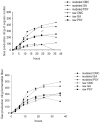In vitro degradation and fermentation of three dietary fiber sources by human colonic bacteria
- PMID: 23556460
- PMCID: PMC3668776
- DOI: 10.1021/jf3054017
In vitro degradation and fermentation of three dietary fiber sources by human colonic bacteria
Abstract
Although clinical benefits of dietary fiber supplementation seem to depend partially on the extent of fiber degradation and fermentation by colonic bacteria, little is known about the effect of supplemental fiber type on bacterial metabolism. In an experiment using a nonadapted human bacterial population from three normal subjects, the extent of in vitro fermentation was greater for gum arabic (GA) than for psyllium (PSY), which was greater than that for carboxymethylcellulose (CMC). In a separate experiment, in vitro incubation with feces from 52 subjects with fecal incontinence, before and after random assignment to and consumption of one of three fiber (GA, PSY, or CMC) supplements or a placebo for 20-21 days, indicated that prior consumption of a specific fiber source did not increase its degradation by fecal bacteria. Results suggest that the colonic microbial community enriched on a particular fiber substrate can rapidly adapt to the presentation of a new fiber substrate. Clinical implications of the findings are that intake of a fiber source by humans is not expected to result in bacterial adaptation that would require continually larger and eventually intolerable amounts of fiber to achieve therapeutic benefits.
Figures


Similar articles
-
Dietary fiber supplementation for fecal incontinence: a randomized clinical trial.Res Nurs Health. 2014 Oct;37(5):367-78. doi: 10.1002/nur.21616. Epub 2014 Aug 23. Res Nurs Health. 2014. PMID: 25155992 Free PMC article. Clinical Trial.
-
Supplementation with dietary fiber improves fecal incontinence.Nurs Res. 2001 Jul-Aug;50(4):203-13. doi: 10.1097/00006199-200107000-00004. Nurs Res. 2001. PMID: 11480529 Clinical Trial.
-
Fermentation of dietary fibre by human colonic bacteria: disappearance of, short-chain fatty acid production from, and potential water-holding capacity of, various substrates.Scand J Gastroenterol. 1993 Mar;28(3):249-55. doi: 10.3109/00365529309096081. Scand J Gastroenterol. 1993. PMID: 8383353
-
Bacterial fermentation of complex carbohydrate in the human colon.Eur J Cancer Prev. 1995 Oct;4(5):353-8. doi: 10.1097/00008469-199510000-00004. Eur J Cancer Prev. 1995. PMID: 7496323 Review. No abstract available.
-
[Colonic metabolism of fiber].Nutr Hosp. 2002;17 Suppl 2:11-6. Nutr Hosp. 2002. PMID: 12141180 Review. Spanish.
Cited by
-
Modulation of Adipocyte Metabolism by Microbial Short-Chain Fatty Acids.Nutrients. 2021 Oct 19;13(10):3666. doi: 10.3390/nu13103666. Nutrients. 2021. PMID: 34684670 Free PMC article. Review.
-
Impact of Dietary Fibers on Nutrient Management and Detoxification Organs: Gut, Liver, and Kidneys.Adv Nutr. 2016 Nov 15;7(6):1111-1121. doi: 10.3945/an.116.013219. Print 2016 Nov. Adv Nutr. 2016. PMID: 28140328 Free PMC article. Review.
-
Dietary fiber supplementation for fecal incontinence: a randomized clinical trial.Res Nurs Health. 2014 Oct;37(5):367-78. doi: 10.1002/nur.21616. Epub 2014 Aug 23. Res Nurs Health. 2014. PMID: 25155992 Free PMC article. Clinical Trial.
-
Psyllium reduces inulin-induced colonic gas production in IBS: MRI and in vitro fermentation studies.Gut. 2022 May;71(5):919-927. doi: 10.1136/gutjnl-2021-324784. Epub 2021 Aug 5. Gut. 2022. PMID: 34353864 Free PMC article. Clinical Trial.
-
The Effect of Psyllium Husk on Intestinal Microbiota in Constipated Patients and Healthy Controls.Int J Mol Sci. 2019 Jan 20;20(2):433. doi: 10.3390/ijms20020433. Int J Mol Sci. 2019. PMID: 30669509 Free PMC article. Clinical Trial.
References
-
- Klosterbuer A, Roughead ZF, Slavin J. Benefits of dietary fiber in clinical nutrition. Nutr Clin Pract. 2011;26:625–635. - PubMed
-
- Bliss DZ, Jung HJ, Savik K, Lowry A, LeMoine M, Jensen L, Werner C, Schaffer K. Supplementation with dietary fiber improves fecal incontinence. Nurs Res. 2001;50:203–213. - PubMed
-
- Macfarlane GT, Macfarlane S. Bacteria, colonic fermentation, and gastrointestinal health. J AOAC Int. 2012;95:50–60. - PubMed
-
- Theander O, Aman P, Westerlund E, Andersson R, Pettersson D. Total dietary fiber determined as neutral sugar residues, uronic acid residues, and Klason lignin (the Uppsala method): collaborative study. J AOAC Int. 1995;78:1030–1044. - PubMed
-
- Ahmed AER, Labavitch JM. A simplified method for accurate determination of cell wall uronide content. J Food Biochem. 1977;1:361–365.
Publication types
MeSH terms
Substances
Grants and funding
LinkOut - more resources
Full Text Sources
Other Literature Sources
Medical

